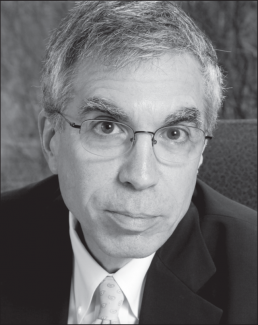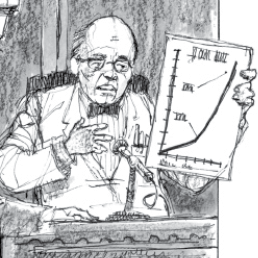There are few public forums to debate the causes and consequences of climate change where the participants won’t find themselves mired in a political maelstrom. On the federal level, where national policies are worked out, partisan gridlock in Congress has taken the legislative branch of government out of play. The current administration has by acts and deeds indicated it has no intention of combatting climate change — quite the opposite. That leaves the fortunes of U.S. climate policies largely dependent upon the composition of the courts, the branch that is concerned only with matters of law and immune from politics.
Carbon emissions in the United States and other big economies like China, India, and elsewhere are on the rise. According to the Trump administration’s Fourth National Climate Assessment, released in November, neither global efforts to mitigate the causes of climate change nor regional efforts to adapt to the impacts currently approach the scales needed to avoid substantial damage to the U.S. economy, our natural heritage, and the health and well-being of Americans. The conclusions reached by the 13 federal agencies and 300 scientists contributing to the assessment reflect the overwhelming consensus of the science community. They affirm the October report of the UN’s Intergovernmental Panel on Climate Change, which set the maximum safe level of warming at only 1.5 degrees Celsius.
Both reports emphasize the urgent need for government action. They identify — with a high degree of confidence — the costly consequences of climate change. These include not only more frequent and intense weather events but also higher rates of morbidity and mortality and lost jobs and investment opportunities in industries affected by carbon emissions, such as fishing, farming, forestry, and insurance.
As the U.S. government fails to put in place policies to combat global warming and adapt to its repercussions, the courts are emerging as the preferred venue in which to debate climate science free of partisan bias and bickering. Citizens are calling for action, and the number of climate-related lawsuits is increasing globally, and nowhere more than in the United States. The cases fall into four broad categories. Some would force government to increase (or some decrease) regulatory oversight and enforcement of existing laws. Others characterize climate change as a rights-based issue. Still others seek to establish climate change as a financial concern. And a final category of cases are designed to contribute to the public debate about the changes to the Earth’s climate system. Naturally there is some overlap, but these distinctions are useful in evaluating the judiciary’s response to global warming.
The most common climate-related cases brought before the courts in the United States continue to be those questioning government regulatory actions involving emissions from coal-fired power plants. Challenges to government regulatory actions have been bidirectional. Obama’s aggressive efforts to combat climate change and protect the environment prompted fossil fuel interests, for instance coal mine operators, to challenge the government’s regulatory authority under existing legislation such as the Clean Air Act, Clean Water Act, and Endangered Species Act. Plaintiffs in the Trump era, however, are predictably suing to prevent the administration from rolling back existing regulations.
Regulatory litigation relies heavily on court precedents, particularly the Chevron doctrine establishing judicial deference to expert agencies, as well as conformity with the Administrative Procedure Act’s requirements for proper notice and public input, and interpretation of legislative language to yield enumerated or implied agency authority. Science in these types of cases plays more of a supporting role. In Massachusetts v. EPA, for example, the Supreme Court was asked in 2007 if the Environmental Protection Agency has the authority to regulate emissions of greenhouse gases from new motor vehicles.
It was the Court’s opinion that EPA is obligated under the CAA to regulate auto emissions which in the administrator’s “judgment cause[s], or contribute[s] to, air pollution . . . reasonably . . . anticipated to endanger public health or welfare.” The Court directed the agency to reconsider its conclusions — although the majority opinion left little doubt about the dangers of vehicle emissions. “The harms associated with climate change are serious and well recognized,” the Massachusetts court said. “The government’s own objective assessment of the relevant science and a strong consensus among qualified experts indicate that global warming threatens, inter alia, a precipitate rise in sea levels, severe and irreversible changes to natural ecosystems, a significant reduction in winter snowpack with direct and important economic consequences, and increases in the spread of disease and the ferocity of weather events.” Still, the Court’s instructions to EPA were to consider whether the above events rise to the threshold required to make an endangerment finding under the CAA and the basis for any regulation of the vehicle emissions at issue. That has left combating climate change up to the political branches, which have been deadlocked on the issue for decades.
Into the breach, a new class of cases claiming the right of citizens to a habitable environment is gaining entrance into state and federal courts, and other cases are inviting the judiciary to be more involved in resolving the controversies surrounding climate change. After all, the Constitution grants to the courts the power and ability to decide “cases and controversies,” and that is exactly what is happening here.
In 2015, a U.S. district court judge in Oregon granted standing to 21 youthful plaintiffs claiming that future generations have a substantive right to be protected from the ravages of climate change under the Due Process Clause of the Constitution. The youths fault the government for inaction in the face of hard evidence. The relief sought by the plaintiffs is science-based policies and regulations to mitigate the impacts of global warming.
The case, Juliana v. United States, has survived multiple attempts — including two before the Supreme Court — to have it dismissed as a political question. Administration attorneys contend that EPA is charged with regulating greenhouse gas emissions, and the court’s intervention confounds the separation of powers on which our political system is based. The case is back before the Ninth Circuit Court of Appeals after the trial judge certified the government’s request for an interlocutory appeal. A decision is expected by the end of March.
Juliana has inspired a host of similar cases — particularly in state courts, where the Public Trust Doctrine has more foundation — around the nation. Should Juliana or other rights-based cases continue to survive dismissal motions, it will be the first time climate science is put on trial.
Another series of cases making it onto court dockets are those based on common law nuisance theory — tortious negligence. Examples of these types of cases are the recent — and so far, unsuccessful — lawsuits by cities, counties, and states seeking compensation from major oil companies for infrastructure damage and other losses attributable to climate change. Many wastewater and drinking water plants are affected by sea-level rise, as are roadways, ports, etc. These cases are similar to the tobacco suits by state governments of the 1980s and 1990s.
In late 2018, in a rare case in which two private entities were party to a climate suit, a food industry sued fossil fuel companies. A California court has granted the Pacific Coast Federation of Fishermen’s Associations standing to sue major oil producers. The petitioner is the largest commercial fishing trade group on the West Coast. On behalf of Dungeness crab fisheries, the organization is seeking $445 million in compensatory damages as a result of toxic algae blooms. The blooms, caused by warming Pacific waters, delayed the opening of the crab season off the California and Oregon coasts, creating economic losses for which recovery is sought. (The Department of Commerce has already allocated $15 million from available disaster assistance funds to help the industry.) The plaintiffs in the crab fishing case, like the state and local governments, are claiming the defendant companies have known for nearly half a century that unrestricted production and use of their fossil fuel products create greenhouse gas pollution. The case may open the door to future negligence suits by private companies against the fossil fuel industry.
Major oil companies and the federal government are not the only ones being sued for knowing the causes and consequences of climate change and choosing to do nothing about it. In 2013 a deluge that overwhelmed a labyrinth of aging sewers and giant tunnels, forcing a noxious mix of sewage and stormwater into local waterways and Lake Michigan, resulted in a lawsuit by Farmers Insurance Company against Chicago-area municipalities for negligently failing to upgrade their systems. An insurance industry expert said of the suit that the companies are in the business of covering unforeseen risks, from accidents. But we’re now at a point with the science where climate change is a foreseeable risk. Thus, a common thread running through the tort cases is establishing what the defendants knew and when.
Importantly, the litigation involves establishing and apportioning liability to monetize damages. These are acts that rely heavily on understanding and accepting climate science as it has grown over the years, and are areas where courts are particularly able to sort out the issues. Theoretically, a courtroom should be the most trusted venue for a rigorous climate-science debate. The judge in City of Oakland v. BP P.L.C., a district court common law nuisance case against major oil companies decided last year, asked the litigants to conduct a two-hour briefing on the science of climate change. In the briefing the opponents in the case all agreed that climate change is as real and damaging as the overwhelming majority of the world’s scientists say it is. The case was dismissed, however, on the grounds that the matter at issue is a political question for the legislative and executive branches to answer. Judge William Alsup, however, articulated his belief that temperatures are rising: “This [court] order fully accepts the vast scientific consensus that the combustion of fossil fuels has materially increased atmospheric carbon dioxide levels, which in turn has increased the median temperature of the planet and accelerated sea-level rise.”
The growing appeal to the judiciary to accomplish what the legislative and executive branches are politically incapable of doing is understandable. As a practical matter, however, the courts alone offer a less than ideal alternative to congressional and executive action. Lawsuits, at one level, are zero-sum. A plaintiff is granted standing to sue or told to go home. Dismissal of a case may be for procedural reasons having nothing to do with the scientific substance of the allegations. Moreover, these emerging classes of cases can take years to reach a conclusion, as the Juliana plaintiffs are finding out nearly four years into their litigation, with a trial yet to be held.
However, long before the last gavel is struck, and the final decision read, climate-rights and liability cases have much to contribute. Through discovery, evidence, testimony, and cross examination, the lawsuits are becoming rich troves of information that may have equal or greater probative value in the court of public opinion than in a court of law.
In the wake of the recent dismissal in City of Oakland are records of the defendant oil companies having agreed with plaintiffs’ factual statements on the causes and consequences of global warming. No matter the outcome in Juliana, the Trump administration has accepted the truth of the mainstream climate-science community and the reality of Earth’s warming.
Notwithstanding the possibility these cases may never be victorious in terms of a binary winning or losing, they present an opportunity for climate defenders and deniers to face off in a moderated, nonpartisan venue governed by longstanding rules of evidence and procedure. Sworn testimony subject to cross-examination offers a counterpoint to ipse dixit pronouncements of opinion in partisan legislative hearings or presidential tweets.
According to Gallup’s last available poll, Republican trust in the judicial branch has gone from 48 percent in 2016 to 79 percent in 2017. At the same time, Republicans, in general, hold the lowest opinions of climate science and climate scientists, according to the Pew Research Center. The distrust of scientists based on their perceived political leanings makes it nearly impossible to expect that deniers will become believers when confronted with hard scientific evidence. So a neutral means of deciding issues concerned with climate science is absolutely essential to convince those who still doubt humanity’s role in warming and required actions.
In Green Mountain Chrysler Plymouth Dodge Jeep v. Crombie, the U.S. District Court for the District of Vermont upheld the state’s plan to approve greenhouse gas emission regulations for new motor vehicles. Vermont’s plan was consistent with the Clean Air Act’s California exemption clause. The litigants both called upon expert testimony concerning the causes and consequences of climate change.
The Green Mountain court noted the Supreme Court’s 1993 conclusions in Daubert v. Merrell Dow Pharmaceuticals, in which the High Court enumerated a list of four non-exclusive considerations bearing on whether a theory is scientifically sufficient to constitute reliable evidence. As stated by the Daubert court, a sufficiency analysis is quantitative rather than qualitative, and “facts or data” may include reliable opinions of other experts and hypotheses that are supported by the evidence. In addition to the four factors listed in Daubert, courts consider whether the expert is testifying about matters based on research independent of the litigation.
To be admitted into evidence an expert’s opinion must be derived by recognized scientific methodologies. Courts are not required to “admit opinion evidence that is connected to existing data only by the ipse dixit of the expert,” as stated in General Electric Co. v. Joiner (1997). An example of such testimony is President Trump’s recent comment that he has a “natural instinct for science” and his uncle was a scientist at MIT, and therefore he knows that climate change is a bogus theory.
Still, climate science isn’t as well-founded as the physics of celestial bodies, for example. But if most scientists are to be believed, immediate action is necessary. A practical consequence of evidentiary rules is the judiciary’s acceptance of reliable testimony that need not be “known to a certainty.” As the judge in Green Mountain wrote, “There are no certainties in science.” Thus, actions to avoid a highly likely risk are called for in the case of climate change, just as we minimize risk of exposure to chemicals that we only suspect of carcinogenicity.
Documents in the Juliana case are now available; they include reports by the litigants’ respective experts. The reports vary in length and detail and are a preview of what the experts will be testifying to in open court. Consider the report of scientists Susan Pacheco and Jerome Paulson, who were retained by the plaintiffs. Their opposite on the defendant’s side is Arthur Partikian. Note when reading the excerpts below that standing requires that a plaintiff must have suffered an actual injury or harm, traceable to the actions of the defendant, and capable of redress by the court.
Although children are not considered a suspect class under the law, the age of the Juliana plaintiffs is integral to their allegations. Pacheco and Paulson state: “Children are uniquely vulnerable to the impacts of climate change due to their physiological features, including their higher respiratory rate, lung growth, and development, immature immune system. . . . [C]ertain populations of children are especially vulnerable. . . [including] children with preexisting medical conditions, children from communities of color, and economically disadvantaged children.”
Partikian responds: “While I do not contest the general concept that factors mentioned by the plaintiffs’ experts as potentially associated with climate change. . . I do not find adequate documentation in the available records and reports.”
Other experts called to the witness stand will testify on whether the nation can run solely on low-carbon technologies like wind and solar. The economic and monetary costs of the transition to a clean energy economy will be debated, as will the social cost of carbon. Ultimately, a jury will have to decide the value of the evidence and what actions, if any, are required by the parties.
In reading through the voluminous motions, complaints, and reports in the novel-legal-claims cases, what is most startling is what they seem not to be about — whether global climate change is real or a hoax. The Trump administration in Juliana has stipulated to the plaintiffs’ statements about the existence of global warming, recognized its harmful consequences, and acknowledged that humans are contributors to the problem in much the same manner as the oil companies are doing in the nuisance cases. The issues, rather, are fault, apportionment, and appropriate response.
The willingness of oil companies and the Trump administration to accede to the petitioner’s climate characterizations reflects a shift in the public position of “mainstream” climate-deniers in recent years. That change was on prominent display during the confirmation hearings of Scott Pruitt to EPA, Ryan Zinke to Interior, Rex Tillerson to the State Department, and other of Trump’s nominees. The new tactic accepts, with certain caveats, that climate change is afoot and acknowledges that human activity is “somehow” a contributor.
In recent months the Trump administration has added a closing statement to the acknowledgment. Buried in a draft environmental impact statement supporting the proposed freeze of auto emission standards at 2020 levels, the administration indicates that any meaningful effort to combat climate change “would require substantial increases in technology innovation and adoption compared to today’s levels and would require the economy . . . to move away from the use of fossil fuels, which is not currently technologically . . . or economically feasible.”
The statement is not made as a call to arms but as a fatalistic foreboding of what the future will hold. The “yes, but there is nothing that can reasonably be done about it” protestations of deniers in public policy arenas is a version of the challenges plaintiffs face in a trial. Should deniers lose in court, they will find there is something to be done and at a price.
It is arguable that the court’s order to do the inventory and in essence draft what for all intents and purposes would be Obama’s Clean Power Plan on steroids could be slowed, if not stopped, by a hostile Congress and White House. In any event whatever would come of the order would be back in the courts from the moment a notice of intent was published in the Federal Register.
Realistically combating climate change will take more than a court’s ordering EPA to write regulations. Absent political considerations of deployment, technological solutions only work on paper. It is not to say that the government is right and that Juliana and other novel-theory cases should be dismissed because the courts would be stepping out of their co-equal role and doing the job of policymaking that is reserved for the legislature and the executive.
Bringing policy considerations into the courtroom will prove as valuable to the public debate as taking validated scientific evidence established in the courtroom and putting it into the court of public opinion. An understanding of the political context — in reality, and not as a hypothetical construct — will help to guide the courts in their consideration of redressability, for example, by allowing the government flexibility to attack the problems from multiple directions.
Synergies exist between court proceedings and public policy debates. Courts are loathe to consider future injuries both because of their speculative nature — there is no guarantee that injuries will arise, and there is difficulty in monetizing the damage that might occur 20 years into the future. In contrast, it is natural for public policies to anticipate and respond to problems likely to pop up in the future, such as increasing a community’s resilience to extreme weather events.
The court testimony of the Juliana medical experts would naturally address the potential damages of cumulative exposure to a climate altered by the release of carbon dioxide, methane, hydrofluorocarbons, and other GHGs. Testimony in the fishing damages case will not only speak to the consequences of warming oceans from carbon released by burning oil but will convert climate concerns into dollar and cents. Although courts may not account for anticipatory damage in their orders and opinions, the information introduced into evidence during the trial would strengthen the public policy debate outside of the courtroom, even if the case is dismissed.
The hyper-partisanship preventing a balanced discussion on climate science in the halls of Congress and the White House also prevents a balanced and rational discussion on possible cures. The value of the courts is not simply to be measured in terms of final outcomes. Under partisan circumstances, the judiciary remains the only venue in which an honest and objective climate debate can occur.
In answer to the government’s claim that a courtroom is not the proper setting in which to weigh the evidence in support of climate change theory, the magistrate judge in Juliana stated: “Whether . . . climate change is occurring, whether . . . human induced, and the degree of its severity and impact on the global climate, natural environment, human health is quintessentially a subject of scientific study and methodology, not solely political debate. The judicial forum is particularly well-suited for the resolution of factual and expert scientific disputes, providing an opportunity for all parties to present evidence, under oath and subject to cross-examination in a process that is public, open, and on the record.”
Redressing the harms alleged by plaintiffs is time constrained. It has already taken the youthful petitioners in Juliana several years to get to trial. How many more years will go by before the Supreme Court makes the final judgment in the case? How many years after that will be required for EPA to do the emissions inventory and draft and implement a new power plan? Should the defendant government and companies in these novel-theory cases start losing in court, they will find there is something to be done and at a price. Yet the latest findings of climate science make it clear that immediate, large-scale actions are required.
Neither the Juliana plaintiffs nor others in pending or anticipated climate-science cases should be expected to carry the burden of a livable environment alone. The growing number of climate-related lawsuits based on novel legal theories will continue to expand at least as long as the government fails to put partisanship aside and do what is necessary to stem Earth’s warming and increase the nation’s resilience to the effects already being experienced.
As different as the emerging novel-legal-theory cases are they share the same objective — a livable environment. Win or lose each can contribute to the overall efforts of climate defenders. What was the role of science in each case? What arguments swayed judges and jurors? Where do the litigants’ experts agree; were there gaps in a plaintiff’s arguments that need to be filled? Did the public rallies in support of the Juliana plaintiffs change the community’s perception of global warming? Is the relief asked for in one case duplicative or additive to what was requested in another? Can the cases be better coordinated to create more holistic solutions to global warming?
Although each climate case is unique, they all share the same objective — a habitable global environment. Legal and policy advocates need to come together to develop an integrated strategy designed to prevail in the court of public opinion as well as of law. Even if a plaintiff loses a case, pursuing it may be validated if the court’s decision includes statements that may be useful for the larger purpose of convincing the public and prodding the political branches to action as a result. TEF



